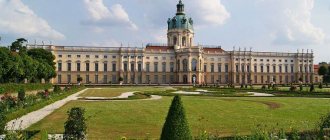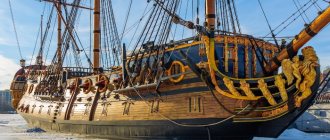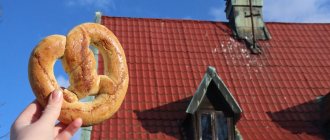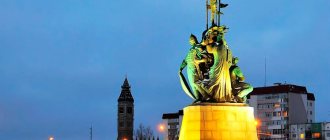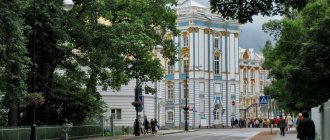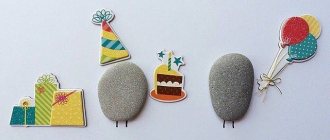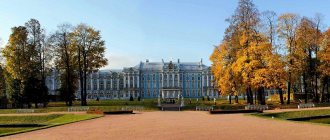Step-by-step route No. 1: “What to see in Moscow in 1 day”
Step 1. From metro station pl. Revolutions to Red Square
The walk starts from the Ploshchad Revolyutsii station (1) of the blue metro line. After leaving the train, find the exit to the city No. 11 to Bogoyavlensky Lane. Then turn right and walk to the pedestrian street Nikolskaya. You will come across the Coffee House coffee shop. To the right of it is house No. 15 with a sundial above the doors (2) . After examining it, go left from the Coffee House and on the right side of Nikolskaya Street at house No. 7 you will see a sign: “Lomonosov studied here” (3) . Continue driving and you will reach Red Square.
Step 1. From the Ploshchad Revolyutsii metro station to Red Square.
- Interesting information about the Ploshchad Revolyutsii station (1). People make wishes at this station. There are bronze sculptures here, which Muscovites attribute magical qualities to. According to legend, you need to rub the sculptures in the right places, and then you will be happy. During rush hour, a queue forms in front of the sculptures. Who is being rubbed and where? 1) Sculpture of a sailor-signalman: in the morning you need to touch the signal flag, and then the whole day will be successful. 2) Sailor with a revolver: three revolvers so that everything goes well with money and good luck in business. By the way, this revolver has already been stolen several times. 3) Bronze girl: rub your shoe if you are looking for happiness in love. 4) Bronze Border Guard Dog with Rifle: Rub the dog's nose for good luck at work or to quit smoking.
- Interesting information about the building with the sundial (2) . This is a former printing house that belonged to the church. Before her, there was a Printing Yard founded by Ivan the Terrible. It was under him that about 450 years ago the first book was printed here in Russia, and under Peter I - the first newspaper. Some historians believe that the emperor personally typed and corrected the text of one of the issues here. Please note that on the façade of the building there is a bas-relief of a Lion and a Unicorn. This was historically a symbol of the Printing House.
- Interesting information about the sign “Lomonosov studied here...” (3). In fact, the full text of the tablet is as follows: “On this site was the building of the Slavic-Greek-Latin Academy, where the great Russian scientist M.V. studied from 1731 to 1735. Lomonosov". The Academy was created at the Zaikonospassky Monastery. You can walk into the territory of the monastery and see the building of the church in which Lomonosov prayed in his free time from study. You can also buy monastery pastries there. The pies are very tasty. Just walk 10 meters from the sign towards Red Square and you will see a large gate above which is written: “Zaikonospassky Monastery”. The gate is usually open.
Step 2. Red Square
So, you left Nikolskaya Street on Red Square. Let's take a walk around it and figure out what is located here and where. Let's go counterclockwise. Let's start with GUM (4) , it is on our left, on the right is the Kazan Cathedral (5) , then the Historical Museum (6) . Between the museum and the Kremlin wall there is a free 24-hour toilet (7). Not even all Muscovites know about him. Nearby is the Nikolskaya Tower (8) and the actual walls of the Kremlin (9) . We walk along the walls and see the necropolis (10) , then the Lenin Mausoleum (11) and the Spasskaya Tower with chimes (12) , across the road from it St. Basil's Cathedral (13) , next to the monument to Minin and Pozharsky (14) , and then Execution Place ( 15 ).
Step 2. What and where is located on Red Square.
- Interesting things about GUM (4). These are former shopping arcades, and now they contain expensive shops. The Neglinka River flows in an underground pipe right under GUM. Mayor Luzhkov claimed that 10-centimeter cockroaches were found in Neglinka. I advise those who are curious to visit a fun attraction in GUM - the most expensive toilet (for 200 rubles). The interiors have been restored from the time of Alexander III: there is a red carpet on the floor, huge mirrors in carved frames on the walls, fresh flowers (there are even orchids) at the sinks, there is hand cream, and instead of paper towels there are fragrant cotton napkins. The historical toilet is located on the 1st floor. I also recommend trying the legendary Gumov ice cream - it has been sold here since 1954. Now you can buy it in beautiful kiosks, also on the 1st floor. The main landmark (especially on weekends) is a long queue, including Chinese tourists.
- Interesting things about the Kazan Cathedral (5). The first Kazan Cathedral on this site was built with the money of the military leader Dmitry Pozharsky. This is the same Pozharsky whose monument stands on Red Square. In 1936, the cathedral was demolished and a cafe was built here. What you see now is a remake that was restored in the 90s. But we tried to make it look similar. You can visit the Kazan Cathedral for free - it is not a museum, but a working church.
- Interesting things about the Historical Museum (6). This building was built specifically to house a museum, and was not converted from someone’s palace, as often happens. The first stone was laid by Alexander II himself, and the museum was opened on the day of his coronation by Alexander III. What is inside? The entire history of Russia from ancient times to our century.
- Interesting things about the toilet (7). Not even every Muscovite knows about the existence of this free 24-hour toilet. It is located on the hill to the right of the Nikolskaya Tower. There is a staircase leading up to it. The toilet itself is not visible from the road because it is underground.
- Interesting things about the Nikolskaya Tower (8). It was built more than 500 years ago. During the occupation of Moscow by the French, the tower was badly damaged by an explosion: the dome collapsed. But what’s interesting: the icon of St. Nicholas the Wonderworker, mounted on the wall of the tower, remained hanging in its place, although the explosion was very strong. Now there is a checkpoint near this tower through which you can go to the Lenin Mausoleum.
- Interesting things about the Kremlin (9). The Kremlin is the Kremlin. It is already more than 870 years old. The President sits there, there is the Tsar Cannon, which has never fired, and the Tsar Bell, which has never rung. Tickets to the Kremlin museums can be purchased in advance here .
- Interesting things about the necropolis (10) . Along the Kremlin wall behind the mausoleum there is a necropolis where famous people were buried. Some were buried in separate graves: for example, Stalin, Dzerzhinsky, Budyonny. Someone was burned and the ashes were buried in an urn: for example, this is how Gagarin, Krupskaya, Korolev were buried. There are also mass graves of revolutionaries famous at that time. You can get to the necropolis only during a visit to the Lenin Mausoleum.
- Interesting information about the Lenin Mausoleum (11). Lenin has been lying here for about 100 years. You can view it for free from 10.00 to 13.00, except Monday and Friday. Bags, cameras, phones and other things must be handed over to the storage room, which is located in the Historical Museum. A checkpoint with a metal detector is located near the Nikolskaya Tower. They launch in groups, the line is sometimes long, but moves quickly.
- Interesting information about the Spasskaya Tower with chimes (12 ). Every year we open champagne during the chiming of the chimes on this tower. The modern type clock was installed here 150 years ago, and was made in a factory for the production of winnowing machines and threshers.
- Interesting things about St. Basil's Cathedral (13) . The temple was built by order of Ivan the Terrible in honor of the capture of Kazan at the burial site of the wonderworker St. Basil the Blessed. Ivan the Terrible honored and feared the holy fool. When he died, the king helped carry his coffin. According to legend, the architects who built the cathedral were blinded so that they could not build a cathedral of equal beauty anywhere else.
- Interesting information about the monument to Minin and Pozharsky (14) . Let me remind you: Minin is a zemstvo elder who gathered the people’s militia against the Lithuanian-Polish invaders during the Time of Troubles after the death of Ivan the Terrible. And Pozharsky is the military leader who led the troops. Initially, the monument was installed opposite GUM, but it interfered with parades, and it was moved to the cathedral.
- Interesting things about Lobnoye Mesto (15). This is the place from where the royal decrees were announced. Executions were also carried out next to him. But the executions were carried out nearby, and not on the Execution site itself. So the picture “The Morning of the Streltsy Execution” is not entirely reliable. But it must be said that 400 years ago the bodies of the torn associates of False Dmitry I were actually brought to Lobnoye Mesto, who lay here for three days.
Step 3. From Red Square to Lazy Street
From Red Square we will go further along Vasilyevsky Spusk (16) towards the Moskva River (18) . As a result, we will go to the corner Beklemishevskaya tower (17) . Here we turn right and walk along the Kremlin wall. Already from the tower you will see in the distance the Cathedral of Christ the Savior - this is one of the goals of our walk.
We go to the second corner tower , which is called Vodovzvodnaya (19) . Near it we need to turn right and walk a little up to the pedestrian crossing. The crossing is located near the traffic police post. We cross the street, turn left and walk along the sidewalk that goes under the arch of the bridge. Then we walk about another 100 meters and turn right onto one of the shortest streets in Moscow, which is called Lenivka Street (20) .
Step 3. From Red Square to Lenivka Street.
- Interesting things about Vasilyevsky Spusk (16) . In 1987, a German amateur pilot landed here. On the day of the border guard, he crossed the border without hindrance and just as easily flew another 1000 km over the territory of the USSR. He wanted to land on Red Square, but when he realized that he couldn’t do it, he noticed the traffic light cycle and landed at the beginning of Vasilyevsky Descent, and then coasted to St. Basil’s Cathedral. After this, Vasilyevsky Spusk is popularly called Sheremetyevo-3.
- Interesting information about the Beklemishevskaya Tower (17). It was used as a place of torture and as a prison. Even the boyar Beklemishev himself, after whom it was named, awaited his execution in this tower. The tower was named after the boyar not because he became famous for something, but simply because his courtyard was located inside the Kremlin and adjacent to the tower. The tower is 530 years old.
- Interesting things about the Moscow River (18). It used to be home to sturgeon, but now it is so dirty that it often contains ugly fish: for example, blind roach or roach with bulging eyes. During the abnormally hot summer of 2010, jellyfish were spotted in the river.
- Interesting information about the Vodovzvodnaya Tower (19). Almost 400 years ago, a mechanism was installed in the tower to lift water from the Moscow River and deliver it through pipes to the city. Such a mechanism cost the treasury several barrels of gold.
- Interesting information about Lenivka Street (20). For a long time it was considered the shortest street in Moscow: its length is only 160 meters. They said that Lenivka was so short because she was too lazy to grow up. The street is quite beautiful and has well preserved its historical appearance. I even saw how it was once used as a set for the filming of some historical film.
Step 4. From Lenivka Street to Gogolevsky Boulevard
We pass Lenivka Street and find ourselves on one of the oldest streets in Moscow, called Volkhonka. Directly in front of us is the building of the Museum of Personal Collections (21) . We turn left and after 100 meters on the left side of the street we will see the art gallery of Ilya Glazunov (22) , the so-called Glazunovka. This is a rather interesting museum, which we visited probably three or four times. But a more interesting museum is located opposite Glazunovka across the road. This is the Pushkin Museum (23) . On weekends, a whole crowd of people often lines up around it. In this museum we once met actor Yevgeny Mironov in the locker room.
If you go further along Volkhonka, then 200 meters from these museums on the left there will be the Cathedral of Christ the Savior (24) . I recommend visiting it: it’s beautiful inside and it won’t take much time. You can also go up to the observation deck of the temple: tickets are sold there at the green kiosks nearby. After visiting the temple, cross the pedestrian crossing across Volkhonka Street and go to the Kropotkinskaya metro arch. This is where the park begins along Gogolevsky Boulevard (25) . Walk along it to the very end, where the monument to Gogol is erected.
Step 4. From Lenivka to Gogolevsky Boulevard.
- Interesting information about the Museum of Personal Collections (21). I’ve never been to this museum, but I know that the building used to house a communal apartment, where musician Andrei Makarevich spent his childhood.
- Interesting things about Glazunovka (22). This is a museum dedicated to the paintings of only one artist - Ilya Glazunov. Moreover, the museum was opened during his lifetime, which is rare. The museum is good - you can go. The highlight of the museum is several huge, wall-sized canvases, the subjects of which are events from the difficult history of Russia. I like them very much.
- Interesting things about the Pushkin Museum (23). A very cool museum dedicated to foreign art. There are paintings, sculptures, sarcophagi, and even a mummy of a woman. The opening ceremony of this museum in 1912 was attended by Emperor Nicholas II himself. But the first visitor, according to legend, was the stoker Alexey, who asked to show him the exhibition even before the opening. The museum is called Pushkinsky, but some believe that it would be fairer to call it Tsvetaevsky: it was Marina Tsvetaeva’s father who conceived the idea of founding this museum and did a lot to ensure that it opened.
- Interesting information about the Cathedral of Christ the Savior (24). The temple that we see now was built in the 90s. It stands on the site of a temple of the same name blown up by the Soviet government in 1931. At that time they wanted to build a House of Soviets with a height of 415 meters (that’s about 88 floors). At the very top of the building there was supposed to be a 100-meter Lenin monument. The builders even managed to make a huge foundation, but due to the outbreak of the Great Patriotic War, the project was frozen and then completely forgotten about it. The foundation was later used for the construction of the Moscow outdoor swimming pool. It was the largest pool in the world with a diameter of 130 meters. Muscovites said about the pool: “First there was a temple, then it was rubbish, and now it’s a disgrace.”
- Interesting things about Gogolevsky Boulevard (25) . The boulevard consists of two roadways (those on the sides) and a pedestrian park (the one in the center). All these three parts are located at different levels (in steps), because a stream used to flow here, which had banks of different heights. In the middle of the park there is an interesting monument to Sholokhov. The writer sits in a boat, and behind him the heads of horses protrude from the ground. The horses seem to be floating nearby. Muscovites don’t like these horse heads: they call this monument “Meat Processing Plant” or “Pet Cemetery”. The park ends with a monument to Gogol.
Step 5. From Gogolevsky Boulevard to Arbat
Having passed the Gogol Boulevard park to the end, you will come to the Gogol monument (26) . Now you need to cross the pedestrian crossing to the left side of the street. Walk approximately 130 meters and take the first left. street Arbat (27) begins here . We need it.
Step 5. From Gogolevsky Boulevard to Arbat.
- Interesting information about the monument to Gogol (26). At first there was “sad Gogol” in this place. And Stalin didn’t like the fact that he was sad. As a result, the monument was replaced with the “cheerful Gogol”. There were even epigrams like this: “Gogol’s humor is dear to us, Gogol’s tears are a hindrance. Sitting, he brought sadness, Let him stand now - for laughter!
- Interesting things about Arbat (27). This is a pedestrian, the most famous and very ancient street in the capital. Arbat is a symbol of Moscow; very famous people of Russia lived here: the Golitsyns, Trubetskoys, Sheremetyevs... And also Pushkin, Gogol, Chekhov, Blok and many others. Once a friend of mine rented an apartment here for a couple of days when she went to Moscow for the weekend - you can’t stop living beautifully. Arbat is also home to street artists and performers.
Step 6. Arbat
Let's look at the most interesting things on Arbat. The second lane on the left is called Starokonyushenny. On it, literally 40 meters from the Arbat, there is a very unexpected house of Porokhovshchikov (28) . It's a must see. We looked at the house and again went out onto the Arbat. We walk about another 150 meters and on the right side we see a fountain with a sculpture of Princess Turandot (29) , installed near the Vakhtangov Theater. Standing near Princess Turandot, turn to the other side of the street and look for a house at the intersection of Arbat and Kaloshiny Lane with the name Actor's House written on it. Now look up and find two knights on its facade. This house is called House with Knights (30) .
Go ahead. The next lane going to the left is called Krivoarbatsky. At the very beginning on the right side there is Tsoi’s Wall (31) . We return to Arbat again and carefully look at the signs on the right side of the street. We need to find the “Daily Bread” sign. To the left of it there is a beautiful lattice gate that closes the passage under the arch into the courtyard. On the inside of the arch there are seven “Last Address” signs (32) . To see them, you need to come closer.
We go further to the next lane, which goes to the right. This is Spasopeskovsky Lane. If you walk along it 100 meters, you will find yourself in front of the church where Cheburashka was born (33) .
We return again to Arbat and at the beginning of the next lane going to the left (Plotnikov Lane), we see a monument to Bulat Okudzhava (34) . And on the wall of the corner house, which is located on the left, we find a memorial plaque to Papanin (35) .
We go further along Arbat. About 100 meters from Okudzhava on the right side of the street there is a monument to Pushkin and Goncharova (36) . They stand right in front of the house where they once lived. Now this house houses a museum dedicated to Pushkin.
When you reach the end of Arbat , turn right and exit onto the busy Garden Ring.
Step 6. What interesting things to see on Arbat.
- Interesting things about Porokhovshchikov's house (28) . This is a very unexpected house. Firstly, this is an old wooden house, which 150 years ago received an award at the World Exhibition in Vienna. Secondly, this house was built by Alexander Porokhovshchikov (a philanthropist who allocated huge funds for the construction of the Cathedral of Christ the Savior), and then began to belong to his great-grandson, whose name was also Alexander Porokhovshchikov. We all know him as a famous Soviet actor. Remember the movie "Voroshilov's Shooter"? He played the role of a police colonel there. And the actor’s wife hanged herself in this house. She, by the way, was a distant relative of Marshal Zhukov. This is such an unusual house.
- Interesting information about the fountain with Princess Turandot (29) . This is a monument to the play of the same name, staged by Evgeny Vakhtangov. It is located right next to the Vakhtangov Theater. All sorts of informal people like to gather around this fountain. Turandot, by the way, was a cruel Chinese princess who, in order not to get married, came up with a difficult test for applicants. Anyone wishing to get married had to guess three difficult riddles. And whoever doesn’t guess will be executed.
- Interesting things about the House with Knights (30 ). It is believed that this knight became the prototype for the image of Koroviev in the novel “The Master and Margarita”. And about this knight, the bard Evgeny Agranovich wrote a humorous song “The Last Knight on the Arbat.” Unfortunately, Agranovich has already died, but I had a chance to listen to him live and even get an autograph from him. And the lyrics to the song are:
Keeping the precepts of chivalry, Of course, you will accompany me on foot to Sokolniki, my dear?
The last knight on the Arbat Stands on the house thirty-five. I will sleep in my bed, and he can accompany you!
- Interesting information about the Tsoi Wall (31). It appeared here spontaneously in 1990, on the day the musician crashed his car. Someone wrote on this wall: “Today Viktor Tsoi died. We will respect you! " In response, another unknown person wrote: “Tsoi is alive.” And away we go... They wrote on the wall, drew, and left messages for each other. They tried to ban the wall, they painted it over, but it is being revived and is constantly in motion, because more and more graffiti is being applied to it.
- Interesting information about “Last address” signs (32). This project was created so that people remember the names of those repressed during the years of Soviet power. Anyone can order such a sign on this site if they know the name of the innocently convicted person. There are seven signs hanging on this particular house. All these 7 people were allegedly foreign spies or terrorists. They were all shot and all were later rehabilitated.
- Interesting information about the church where Cheburashka was born (33). It was in this church, which is already 300 years old, that in Soviet times one of the premises of Soyuzmultfilm was located, where they made dolls for cartoons. So, they came up with and made Cheburashka in this building. And the crocodile Gena was also created here. And the name of the church is: the Church of the Transfiguration on the Sands.
- Interesting information about the monument to Bulat Okudzhava (34). It is no coincidence that the monument stands here. The poet lived in house No. 43, which is located next door. Even the then mayor of Moscow, Yu. Luzhkov, and the president’s wife, Naina Yeltsin, were present at the opening of the monument.
- Interesting information about the Papanin tablet (35). We should not confuse him with Papanov, who is an actor. Papanin headed the world's first drifting station. It was an ice floe measuring 3 by 5 km and only 3 meters thick. The Papanins sailed 2,500 km on it in 274 days. Many children then wanted to become polar explorers.
- Interesting information about the monument to Pushkin and Goncharova (36). The monument was erected here because opposite is the house where Pushkin lived with Goncharova for three “honey” months immediately after the wedding. He said that he didn’t write a single line here because he was very happy. And few people know that Marina Tsvetaeva, a friend of Lermontov and a relative of Tchaikovsky, also lived in this house. Mayakovsky, Meyerhold and Rachmaninov visited here.
Step 7. From Arbat to Vozdvizhenka
Turning right from Arbat , we go out onto the Garden Ring (37) . Walk along it for about 650 meters and, turning right again, you will exit onto New Arbat (38) . At the very end of New Arbat, pay attention to the Church of Simeon the Stylite (39) , which is located on its left side. At the end of the street we cross the underground passage through Gogolevsky Boulevard and exit onto Vozdvizhenka Street.
Step 7. From Arbat to Vozdvizhenka Street.
- Interesting things about the Garden Ring (37). Now it is a ring road in the center of Moscow. Previously, there was an earthen rampart here and an oak wall 15 km long.
- Interesting things about Novy Arbat (38). This is the complete opposite of Old Arbat. He is soulless, and Muscovites call him “the dentures of Moscow.” There are almost no historical sights on it. But we will still walk along it to see a different Moscow. This part of Moscow is exactly the way they wanted it to be in the 60s, thinking that high-rise bookstore buildings were cool. To build such a wide street, many historical buildings and alleys had to be destroyed. The famous square, which was called the Dog Playground, was also demolished.
- Interesting information about the Church of Simeon the Stylite (39). Many famous people were married in this church. For example, Count Sheremetyev, the first wife of the writer Mikhail Bulgakov, actor Nikolai Karachentsov. This church is 350 years old, and it survived demolition because the architect-restorer climbed into the bucket of an excavator and did not allow it to work until the order was given that the church would be preserved.
Step 8. Along Vozdvizhenka to Alexander Garden
We go further along Vozdvizhenka. The unusual house No. 16 in the Moorish style on the left side is the Morozov mansion (40) . And opposite it on the right side is Volkonsky’s house (41) . It is numbered No. 9. At the very end of the street on the right hand there will be the Lenin Library (42) . Here we need to cross the underground passage across Mokhovaya Street. We will go to the Manege building (43) . We walk a little more and find ourselves in the Alexander Garden (45 ).
Step 8. Along Vozdvizhenka Street to the Alexander Garden.
- Interesting information about Morozov's mansion (40). When millionaire Arseny Morozov built this unusual castle-house in the Moorish style, his mother told him: “Before, I was the only one who knew that you were a fool, but now all of Moscow will know!” Actually, Muscovites really mocked this house. But now government international negotiations are being held here. Having built an absurd house, Morozov died just as absurdly. He shot himself in the leg on a dare and died three days later from blood poisoning.
- Interesting information about Volkonsky's house (41). Leo Tolstoy’s grandfather, whose name was Nikolai Volkonsky, lived here. It is believed that he was the prototype of the old Prince Bolkonsky from the novel “War and Peace”. Leo Tolstoy himself often visited this house.
- Interesting things about the Lenin Library (42). This is the so-called Leninka - the main library of the country. Elements of the bombed Cathedral of Christ the Savior were used to decorate the building. Previously, on the site of the library there was an Oprichninny yard, in other words, Ivan the Terrible lived here.
- Interesting things about Manege (43). Now it is an exhibition hall, but it was built 200 years ago by order of Alexander I for drill training. There could be 2,000 people marching there at the same time. And there Leo Tolstoy learned to ride a bicycle and constantly ran into some fat lady on another bicycle. It’s also funny that the attic here was filled with half a meter of shag to prevent mice from gnawing on the ceilings. Museum workers say that all the shag was smoked by soldiers during the Great Patriotic War.
- Interesting things about the Alexander Garden (44). This park was laid out in 1812 on the orders of Alexander I on the site of the Neglinka River, which was hidden underground in a pipe. It still flows there. There are very cool excursions along Neglinka. You and your guide (digger) go down underground and in the dark through the sewer you travel through the real “Moscow region”. For example, Nikita conducts such an excursion, it is called “With a digger along the underground Neglinka River .
Step 9. From Alexander Garden to kilometer zero
In the Alexander Garden we are greeted by the Kutafya Tower (45) . We go around it on the left side and, walking along the path to the Kremlin walls, we run into the large metal gate of the guardhouse (46) . From this gate comes the changing of the guard to the Tomb of the Unknown Soldier. There is a corresponding sign on the wall. Now we turn left and walk through the park. To our right is the Italian Grotto (47) . We go further and also on the right we see the grave of the unknown soldier (48). Watch the honor guard change and walk through the large metal gate to the Zhukov monument (49) .
Go around the Zhukov monument on the left side and walk between the two museum buildings. Here is kilometer zero (50) . True, a milepost with a zero kilometer mark is not installed here. The mark is simply made on the ground. Usually here they make wishes and throw coins over their left shoulder, trying to hit the center of the mark. This is where our route ends.
From Alexander Garden to zero kilometer
- Interesting things about the Kutafya Tower (45) . This is an outrigger tower. Previously, it was well protected by the waters of the Neglinka River. Now Neglinka flows underground in a pipe. Boris Godunov entered the Kremlin through the gates of this tower for his crowning ceremony, and in 1812 Napoleon’s soldiers entered through it. Now tourists enter the Kremlin on excursions through this tower.
- Interesting facts about the changing of the guard (46) . If you want to follow the full path of the guard of honor, then you must wait for its exit at this gate. The guard changes every hour from 08.00 to 20.00.
- Interesting information about the Italian Grotto (47). It was made from the rubble of Moscow buildings destroyed after the Napoleonic War. The grotto symbolizes the restoration of the city from the ashes of war.
- Interesting information about the Tomb of the Unknown Soldier (48). Now this is post No. 1, where an honor guard serves. Previously, post No. 1 was the Lenin Mausoleum. The guard changes every hour from 08.00 to 20.00. If you have time, wait and watch - very interesting.
- Interesting information about the monument to Zhukov (49). The monument was made by my fellow countryman, the sculptor Klykov (from Kursk). Many believe that the monument was placed here out of place. By the way, $3 million was spent on the monument.
- Interesting information about the zero kilometer sign (50) . This is the starting point for distances along roads. They also make wishes here. You need to stand in the center of the sign, make a wish and throw a coin over your left shoulder.
Essays based on paintings of Moscow
Painting by Vasnetsov “Moscow Kremlin under Ivan Kalita”
Essay - Painting by Vasnetsov “Moscow Kremlin under Ivan Kalita” - the artist painted many paintings. His older brother greatly influenced his work. But, unlike his brother, Apollinaris often painted paintings on a historical theme. Among them are several paintings about Moscow. “The Moscow Kremlin under Ivan Kalita” also belongs to him.
Painting by Ryabushkin “Moscow girl of the 17th century”
Essay - Ryabushkin’s painting “Moscow Girl of the 17th Century” - the master’s painting depicts an unusual girl walking with a swift gait along a winter street. It is unclear how pretty the girl herself is, but her graceful gait is very beautiful.
Pimenov’s painting “New Moscow”
Essay - Pimenov’s Painting “New Moscow” - in those years Moscow was special, in the 1930s construction was actively going on, everything was done for the sake of progress, people lived under the influence of the ideology of a “bright future”. It was precisely this period in the development of Moscow that Pimenov reflected in his work “New Moscow”.
Essays on literary topics about Moscow
Famusovskaya Moscow
Famusovskaya Moscow in the comedy “Woe from Wit” - Every time Griboyedov came to Moscow, he saw how Moscow was rebuilt after the war and changed. New buildings appeared here and there, and pavement tiles lined the streets. How has Moscow society and people changed? Griboyedov found every time that it did not change at all. The same rules reigned there as before.
Moscow is not an ordinary big city, of which there are a thousand
Essay on Lermontov “Moscow is not an ordinary big city, of which there are a thousand” - M. Yu. Lermontov lived in the Caucasus for quite a long time. He was in love with the Terek and nature, the south, but he also loved Moscow. Walking around the city was a pleasure for young Mikhail. The best years of his childhood and youth passed here.
Moscow in the novel Evgeny Onegin
Essay “Moscow in the novel Eugene Onegin” - during the events of the novel “Eugene Onegin” the capital of the Russian Empire was the brilliant St. Petersburg, but as a truly Russian person, A. Pushkin could not help but mention Moscow in his novel about the life of the Russian nobility, especially considering that the enormous role that has historically been assigned to it.
